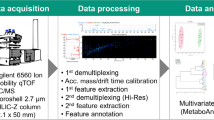Abstract
Ion mobility spectrometry coupled to multi capillary columns (MCC/IMS) combines highly sensitive spectrometry with a rapid separation technique. MCC\IMS is widely used for biomedical breath analysis. The identification of molecules in such a complex sample necessitates a reference database. The existing IMS reference databases are still in their infancy and do not allow to actually identify all analytes. With a gas chromatograph coupled to a mass selective detector (GC/MSD) setup in parallel to a MCC/IMS instrumentation we may increase the accuracy of automatic analyte identification. To overcome the time-consuming manual evaluation and comparison of the results of both devices, we developed a software tool MIMA (MS-IMS-Mapper), which can computationally generate analyte layers for MCC/IMS spectra by using the corresponding GC/MSD data. We demonstrate the power of our method by successfully identifying the analytes of a seven-component mixture. In conclusion, the main contribution of MIMA is a fast and easy computational method for assigning analyte names to yet un-assigned signals in MCC/IMS data. We believe that this will greatly impact modern MCC/IMS-based biomarker research by “giving a name” to previously detected disease-specific molecules.



Similar content being viewed by others
References
Armenta S, Alcala M, Blanco M (2011) A review of recent, unconventional applications of ion mobility spectrometry (IMS). Anal Chim Acta 703:114–123
Eiceman GA, Zarpas Z (2005) Ion mobility spectrometry, 2nd edn. CRC Press, Boca Raton, p 388
Kanu AB, Hampikian G, Brandt SD, Hill HH Jr (2010) Ribonucleotide and ribonucleoside determination by ambient pressure ion mobility spectrometry (IMS). Anal Chim Acta 658:91–97
Karpas Z, Guaman AV, Calvo D, Pardo A, Marco S (2012) The potential of ion mobility spectrometry (IMS) for detection of 2,4,6-trichloroanisole (2,4,6-TCA) in wine. Talanta 93:200–205
Vautz W, Baumbach JI, Jung J (2006) Beer fermentation control using ion mobility spectrometry—results of a pilot study. J Inst Brew 112:157–164
Vautz W, Bödecker B, Bader S, Baumbach JI (2008) Recommendation of a standard format for data sets from GC/IMS with sensor-controlled sampling. Int J Ion Mobil Spectrom 11:71–76
Guaman AV, Carreras A, Calvo D, Agudo I, Navajas D, Pardo A et al (2012) Rapid detection of sepsis in rats through volatile organic compounds in breath. J Chromatogr B Anal Technol Biomed Life Sci 881–882:76–82
Perl T, Bödecker B, Jünger M, Nolte J, Vautz W (2010) Alignment of retention time obtained from multicapillary column gas chromatography used for VOC analysis with ion mobility spectrometry. Anal Bioanal Chem 397:2385–2394
Vautz W, Nolte J, Fobbe R, Baumbach JI (2009) Breath analysis—performance and potential of ion mobility spectrometry. J Breath Res 3:036004
Westhoff M, Litterst P, Freitag L, Baumbach JI (2007) Ion mobility spectrometry in the diagnosis of sarcoidosis: results of a feasibility study. J Physiol Pharmacol 58:739–751
Bödeker B, Davies AN, Maddula S, Baumbach JI (2010) Biomarker validation—room air variation during human breath investigations. Int J Ion Mobil Spectrom 13:177–184
Baumbach JI (2009) Ion mobility spectrometry coupled with multi-capillary columns for metabolic profiling of human breath. J Breath Res 3:034001
Jünger M, Bödeker B, Baumbach JI (2010) Peak assignment in multi-capillary column-ion mobility spectrometry using comparative studies with gas chromatography-mass spectrometry for VOC analysis. Anal Bioanal Chem 396:471–482
Baumbach J, Bunkowski A, Lange S, Oberwahrenbrock T, Kleinboelting N, Rahmann S, Baumbach JI (2007) IMS2—an integrated medical software system for early lung cancer detection using ion mobility spectrometry data of human breath. J Integr Bioinforma 4(3):75:71–12
Maddula S, Rupp K, Baumbach JI (2012) Recommendation for an upgrade to the standard format in order to cross-link the GC/MSD and the MCC/IMS data. Int J Ion Mobil Spectrom 15:79–81
Bunkowski A (2010) Software tool for coupling chromatographic total ion current dependencies of GC/MSD and MCC/IMS. Int J Ion Mobil Spectrom 13:169–175
Bödeker B, Vautz W, Baumbach JI (2008) Peak finding and referencing in MCC/IMS-data. Int J Ion Mobil Spectrom 11:83–87
Wenig Odermatt JP (2010) OpenChrom: a cross-platform open source software for the mass spectrometric analysis of chromatographic data. BMC Bioinforma 11
Wang M, Vandermaar AJ, Srivastava KD (2002) Review of condition assessment of power transformers in service. Electr Insul Mag 18:12–26
Acknowledgments
The financial support of the Ministry of Education Science and Technology (MEST) of the Republic of Korea is acknowledged thankfully (KE). Part of the work of this paper has been supported by the Deutsche Forschungsgemeinschaft (DFG) within the Collaborative Research Center (Sonderforschungsbereich) SFB 876 Providing Information by Resource-Constrained Analysis, project TB1 Resource-Constrained Analysis of Spectrometry Data (JIBB). JB is grateful for financial support from the Cluster of Excellence for Multimodel Computing and Interaction and the Villum Foundation. ACH is grateful for financial aid provided by the International Max Planck Research School, Saarbrücken, Germany. We thank Joachim Müller for software development.
Author information
Authors and Affiliations
Corresponding author
Additional information
F. Maurer and A.-C. Hauschild contributed equally to this work.
Rights and permissions
About this article
Cite this article
Maurer, F., Hauschild, AC., Eisinger, K. et al. MIMA—a software for analyte identification in MCC/IMS chromatograms by mapping accompanying GC/MS measurements. Int. J. Ion Mobil. Spec. 17, 95–101 (2014). https://doi.org/10.1007/s12127-014-0149-5
Received:
Accepted:
Published:
Issue Date:
DOI: https://doi.org/10.1007/s12127-014-0149-5




